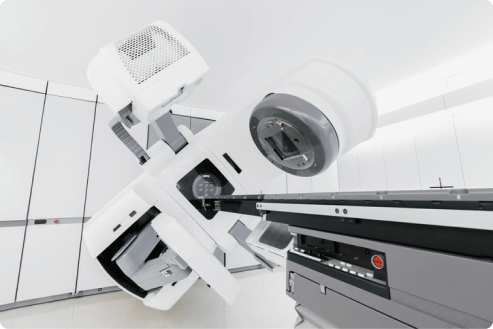Proton Therapy for Mesothelioma Treatment
Proton therapy is an alternative to traditional radiation therapy. It allows doctors to direct more energy into mesothelioma tumors without increasing the risk of collateral damage to nearby vital organs.

What Is Proton Therapy?
Thanks to new technology, doctors can now point radiation at the tumor and adjust how strong it is with more accuracy.
Traditional radiation can be tricky to use when treating mesothelioma. It often grows near important body parts that could get hurt by the radiation.
For pleural mesothelioma, these organs include the lungs, heart and liver. For peritoneal mesothelioma, they include the intestines, kidneys and other organs of the gut. The esophagus, spine and bone marrow are all sensitive to radiation damage as well.
Proton therapy offers one solution to this problem.
Proton Therapy Facts
- Allows radiation oncologists to safely administer higher doses of radiation
- Reduces risk of radiation damage to vital organs
- Can replace traditional radiation in a multimodal treatment plan
- Available only at specialized cancer treatment centers
Instead of using a regular beam of radiation, doctors can use protons to target cancer cells. This helps protect healthy tissue from getting too much radiation and lowers the risk of side effects. It also may make it easier for doctors to treat the cancer more effectively.
Proton therapy is best suited for treating a localized, early-stage tumor. When combined with chemotherapy and surgery, it has proven at least as effective as traditional radiation.
There is not enough hard data yet to say whether proton therapy is more effective than other types of radiation therapy for mesothelioma. Early reports from pioneering doctors and cancer survivors suggest the technology shows promise. This therapy is not common for mesothelioma, but some radiation oncologists prefer it over other methods.
The proton beam provides much more conformal radiation, which means higher doses to tumors and lower dosages to critical structures nearby.Dr. Joe ChangMD Anderson Cancer Center Department of Radiation Oncology
Proton Versus Traditional Radiation Therapy
Proton therapy and traditional radiation therapy share many of the same basic features.
Similarities Between Proton Therapy and Traditional Radiation
- Both seek to damage cancer-cell DNA, preventing reproduction or causing cell death.
- Both types of radiation can be “intensity modulated.” This means a computer controls precisely how much radiation is aimed at each part of the tumor.
- The treatments are quick and painless, with each session typically lasting less than an hour and causing only mild side effects.
The differences between the two treatments come from the types of energy involved.
Traditional radiation uses photons, which are what X-rays, radio waves and visible light rays are made of. Protons, on the other hand, are one of the basic building blocks of matter, along with neutrons and electrons.
Photon and proton beams interact with a cancer patient’s body in distinct ways.
| Photons (Traditional Radiation) | Protons |
|---|---|
| Deposit much of their energy as soon as they enter the body | Deposit only a small fraction of their energy when they enter the body |
| Deposit some of their energy in the tumor, but not as much as in the healthy tissue in front of the tumor | Slow down and come to a stop in the tumor, where they deposit all their remaining energy |
| Deposit some of their remaining energy in the healthy tissue behind the tumor and then exit the body on the other side | Leave the healthy tissue behind the tumor mostly unaffected |
Traditional radiation has limits to how much it can be controlled. With proton therapy, doctors can also decide where the beam should stop and release the majority of its energy.
The radiation oncologist is able to adjust the speed of the protons, so they can stop exactly at a certain depth in the patient’s body. For example, if a tumor is 4 centimeters below the skin, it can be set to stop there.
The science behind this is complex. The doctor has to think about how different body parts are made up and also consider if the tumor moves when a patient breathes.
A radiation oncologist with the right equipment can give a stronger dose of treatment than they could with regular radiation. This means they can safely administer a higher dose of therapy, potentially killing more cancer cells.

Find the top cancer centers trusted by mesothelioma patients nationwide.
Get Help NowProton Therapy for Mesothelioma
In 2021, scientists found that proton therapy is better at protecting healthy tissue than other radiation treatments. It also reduces the amount of radiation used on non-cancerous organs like the lungs, heart, liver, kidneys and stomach.
The downside is it’s expensive to get and requires special skills to use properly. Scientists are just now starting to look into how proton therapy can help mesothelioma patients.
In 2014, a retrospective study reviewed the outcomes of seven pleural mesothelioma patients. It confirmed proton therapy reduces the amount of radiation received by the lungs, heart, esophagus and liver compared to traditional radiation therapy.
In 2017, researchers reported on three case studies of pleural mesothelioma patients. Each received proton therapy after undergoing standard chemotherapy and then major surgery to remove a lung.
- A 71-year-old patient with stage 3 cancer survived for 25 months after multimodal treatment. At the 20th month, he also began receiving immunotherapy.
- A 47-year-old patient with stage 4 mesothelioma survived for only 4 months after multimodal treatment. During the surgery, the surgeons discovered his cancer had spread further than anticipated, making it more difficult to target with proton therapy.
- A 46-year-old patient with stage 3 cancer was still alive at the time of the study’s writing, 14 months after the multimodal treatment. There was no evidence of disease progression. The patient’s symptoms were manageable with physical therapy and medication.
For patients who undergo surgery while their cancer is still localized, proton therapy can help them survive far longer than the typical life expectancy.
Who Is Eligible for Proton Therapy?
Proton therapy is primarily recommended for patients with localized cancer. Unfortunately, mesothelioma is a rapidly spreading disease, and many patients are diagnosed with a late cancer stage.
Proton therapy is not an option for many patients.
To be eligible to receive proton therapy as part of an aggressive multimodal treatment approach, patients must also be in good enough overall health to withstand and recover from major surgery.
Other requirements to be a candidate for proton therapy include:
- Weight of under 360 pounds (equipment may not be able to accommodate larger patients)
- Ability to commute to or stay near the treatment facility for daily appointments
Mesothelioma is a rare type of cancer, and proton therapy remains an uncommon type of cancer treatment. To find a medical team that specializes in both, patients must seek treatment at a top cancer center. This may involve traveling long distances.
Proton therapy also remains a very expensive type of treatment.
Treatment Process
This therapy is delivered over the course of one to eight weeks. The length of treatment is dependent on the dose of radiation required to treat the cancer. Higher doses of radiation are given in shorter cycles. Lower doses of radiation are delivered over a longer period of time.
To prepare for the procedure, patients undergo a simulation session a week before treatments are set to begin.
During a therapy session, patients are positioned on a device that prevents the body from moving. Using markings made during the simulation session, the radiation therapist aims the radiation beam and administers the dose from a control room.
Throughout the 30- to 90-minute treatment sessions, patients can communicate with their radiation therapist via a two-way intercom. The procedure is painless and carries a low risk of side effects and complications.
Recommended Reading


